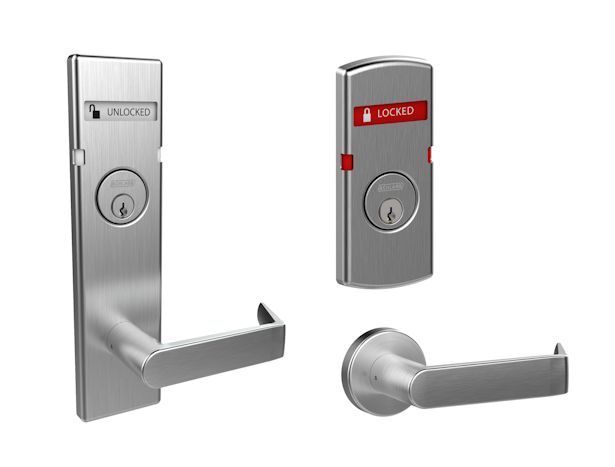You may have read the AP article that appeared in the news media across the country over the weekend, addressing some of the concerns associated with classroom barricade devices. In case you missed it, here’s a link to the story in the New York Times. Although this article is an improvement over some of the past articles which touted the perceived benefits of classroom barricade devices without any mention of the safety issues, there were several points omitted that could have provided a more complete picture.
The article begins by talking about, “A nationwide push allowing schools to buy portable barricade devices…” which gives the impression that these devices are widely desired by schools across the country. Although there are some school districts that would like to use this inexpensive form of security or that have already purchased the devices, the vast majority of school security protocols utilize standard locksets that provide the necessary level of security without jeopardizing safety or violating code requirements.
In the paragraph addressing the recent report from the Ohio Board of Building Standards and the state legislation to override the Board’s conclusion, the author states, “…the board was forced to update its codes to allow the devices after lawmakers approved them…” The new Ohio law did not approve the use of barricade devices without restriction – the law requires the Ohio BBS to adopt rules for the use of the devices. Those rules are due by March of 2016, and may include limitations that will exclude some types of barricade devices from use in Ohio schools.
In a September advisory from the Ohio Board of Building Standards, schools were cautioned against purchasing and deploying barricade devices before the rules go into effect, “as some devices may not comply with the new rules.” The advisory includes the code requirements that affect classroom door locking, with the preface: “In general, the Ohio Building Code (OBC) requires and will continue to require the following for door operation…” (the advisory, including the code requirements can be downloaded here).
The Sandy Hook Elementary School and Chardon High School shootings are cited as incidents that increased the popularity of classroom barricade devices. While it is likely that parents and school districts were motivated by these incidents to address school security, the Final Report of the Sandy Hook Advisory Commission includes several recommendations regarding classroom doors, but does not include classroom barricade devices as a recommended method. When the former Chardon superintendent was asked whether he supports the use of classroom barricade devices, he told members of the Ohio BBS that barricades have the potential to backfire and make active shooter situations more dangerous (more from his testimony is posted here).
Erin West, a parent from the Southwest Licking Schools (the district that raised $30K to purchase barricade devices) is quoted as saying, “I understand that these devices will not save all lives but for my son I want his teacher to have multiple layers of protection.” I’m afraid of what the reaction of parents will be when a barricade device is used by an active shooter or a person intent on committing one of the non-fatal criminal acts that are tens of thousands of times more likely to occur in schools. Adequate classroom security can be provided without sacrificing safety.
The article lists states which have updated their codes to allow barricade devices (Arkansas, Kansas, Michigan, New Jersey and Ohio) “in some cases over the objection of state fire or building officials.” It does not mention states that have changed their codes to require code-compliant locks that can be locked without opening the door, like Florida and California, or states which have issued bulletins reinforcing the current model code requirements (which  classroom barricade devices do not meet), like New York and Minnesota (refer to iDigHardware.com/schools for links to these documents). The majority of states have adopted one of the model codes and have not made changes that allow barricade devices to be used.
classroom barricade devices do not meet), like New York and Minnesota (refer to iDigHardware.com/schools for links to these documents). The majority of states have adopted one of the model codes and have not made changes that allow barricade devices to be used.
Although the article does not mention the potential liability schools may face, and does not share the concerns of law enforcement with regard to their ability to breach doors equipped with barricade devices, it does quote Tom Mynsberge, a retired Michigan state trooper: “If you look at a lot of the shootings, a simple locked door would have prevented a lot of carnage.”
My point exactly.
You need to login or register to bookmark/favorite this content.





Did you forward a link to this blog post to the author of the AP article? If not, I’ll be more than happy to do so.
I think this could be an opportunity to spread the word as you mentioned in a recent post. We are way behind in making people aware of the dangers. Maybe someone will take note of your article and your passion for this and we’ll see you on 11:00 national news.
I didn’t, and it probably wouldn’t do any good. I was in contact with the author as he was working on the article, and I know that one law enforcement expert was interviewed by the author for two hours. None of the information we shared is included in the article, but the barricade device manufacturers are once again allowed to legitimize their products by being quoted. I really don’t understand.
Sounds like something for Bill O’Reilly to handle on his show.
That is because this way it turns up more interest. They are not in the business of selling both sides. Just the side that will sell more. What better way to sell then confuse the reader into thinking that these awesome new products are being prohibited by an anal code person. Shouldn’t the common man know more than the official?
Exactly. 🙁